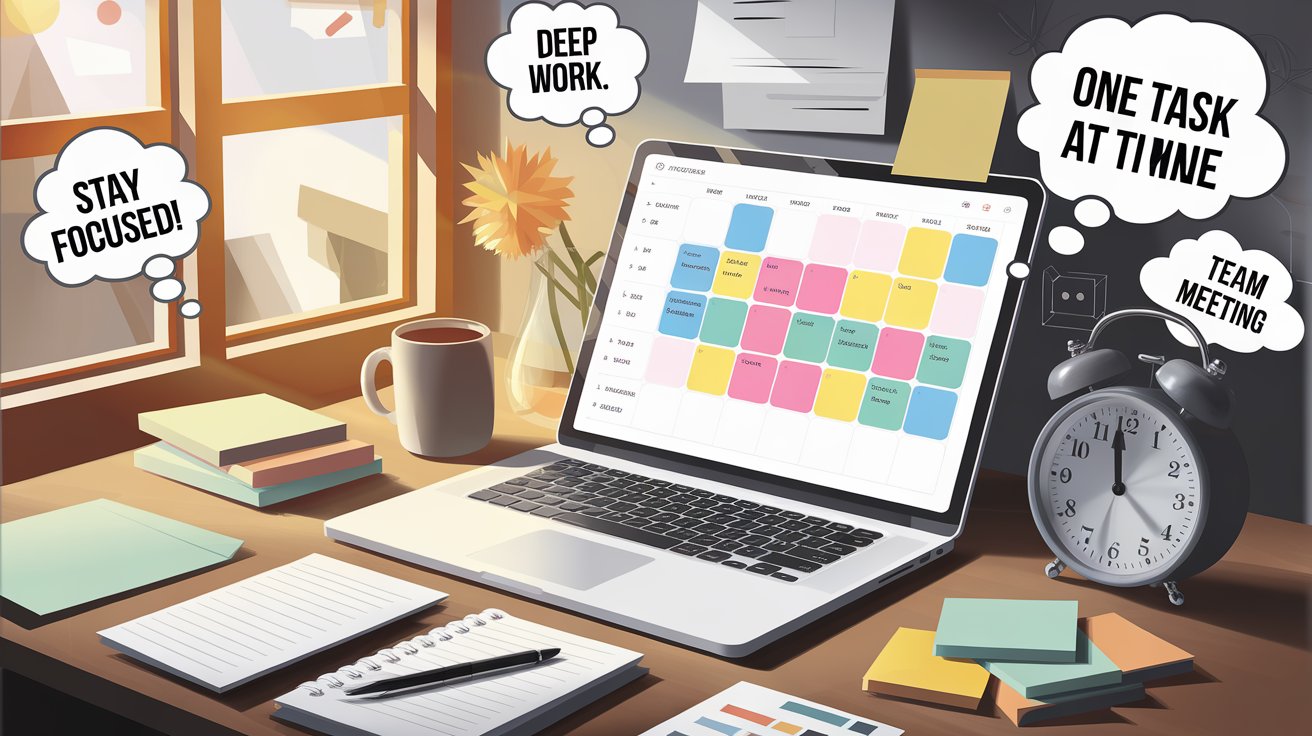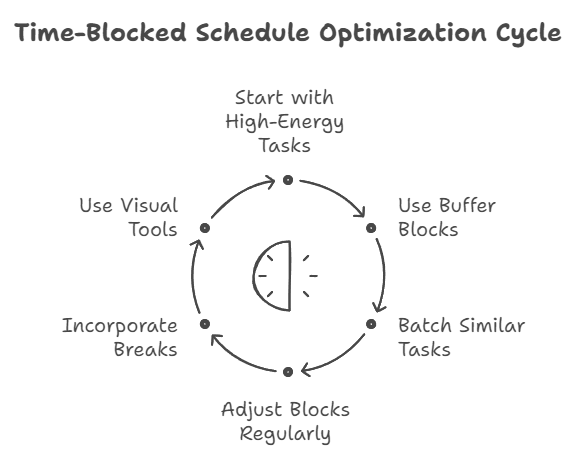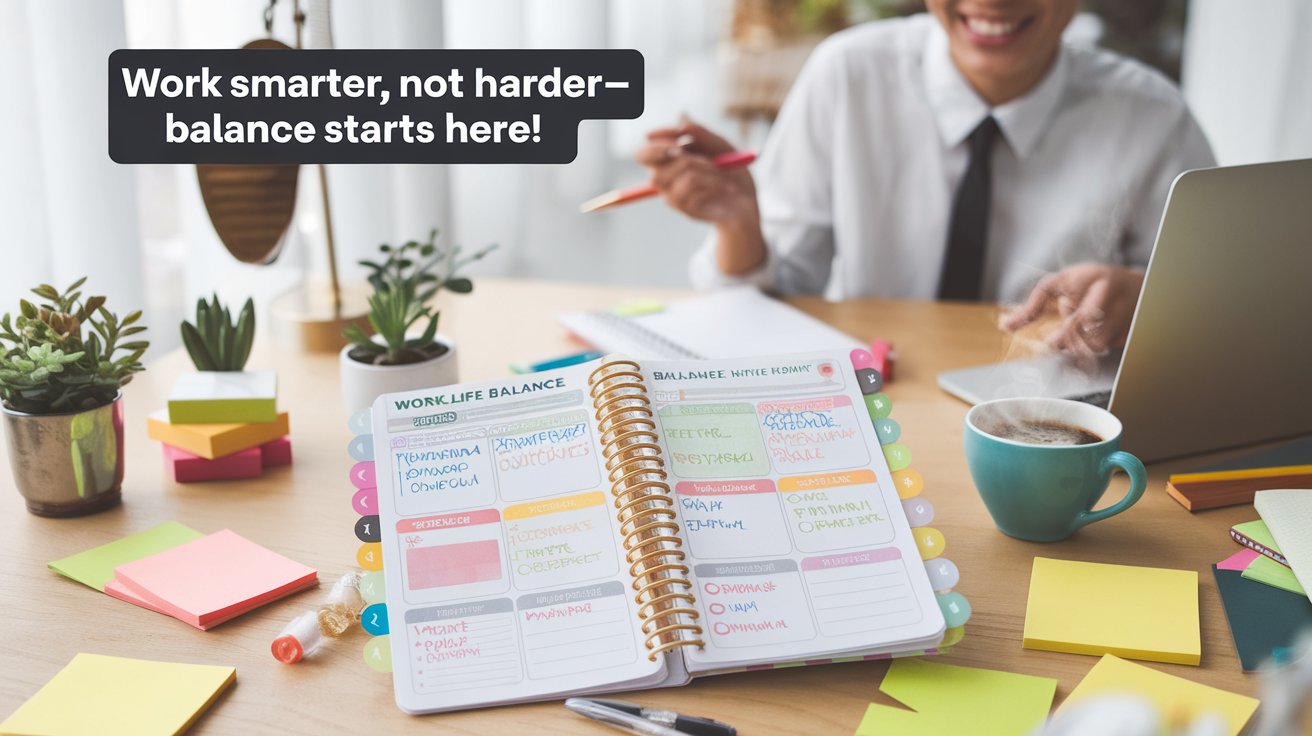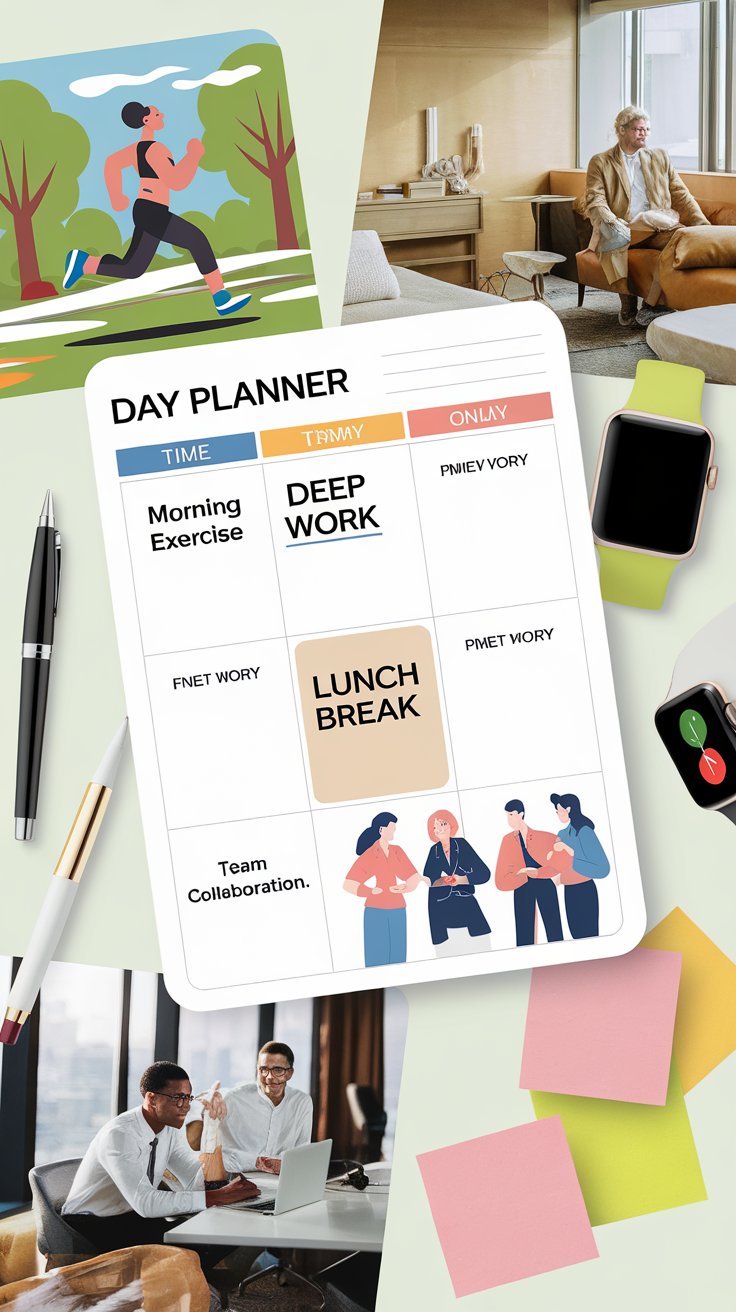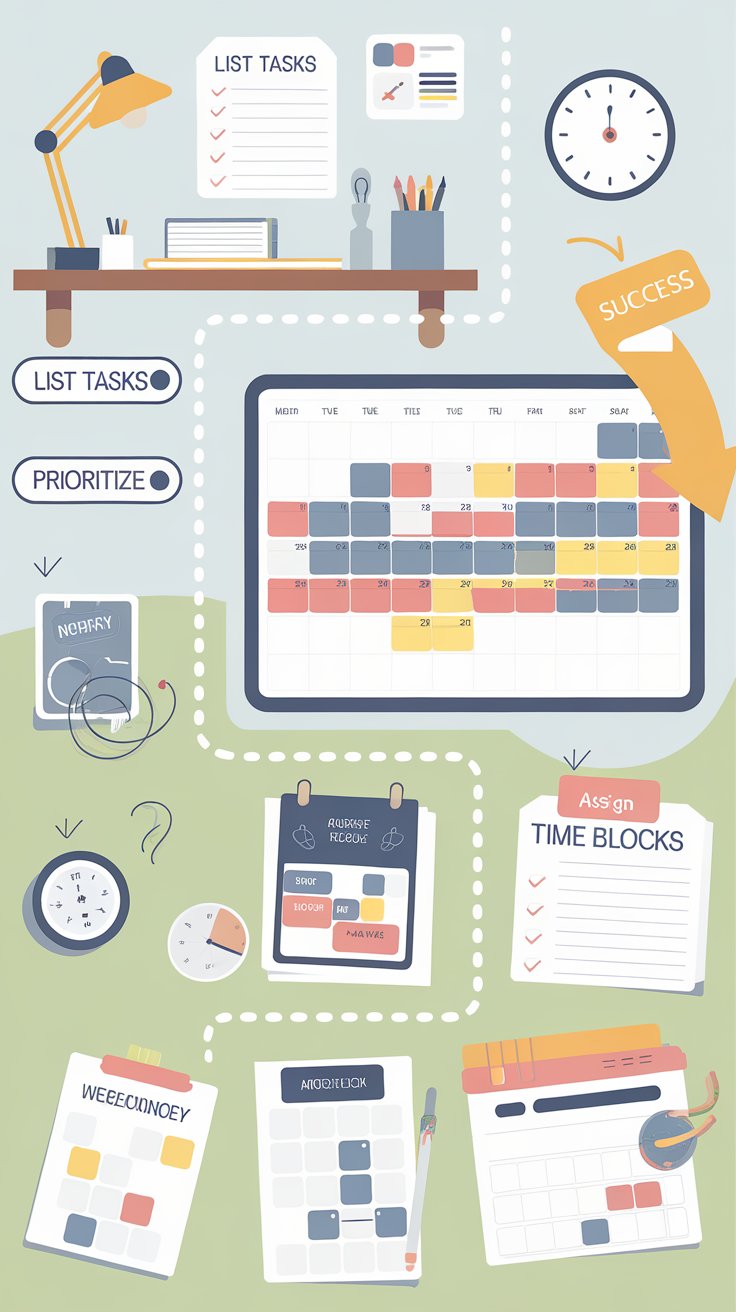Introduction
Time blocking is a highly effective time management technique that divides your day into dedicated blocks for specific tasks or activities. This method helps reduce distractions, improve productivity, and create a structured schedule that prioritizes your most important work. By using tools like Google Calendar or time-tracking apps, you can align tasks with your energy levels and maximize your output throughout the day.
Whether you’re aiming to tackle professional responsibilities, enhance personal development, or maintain a healthy work-life balance, time blocking offers a straightforward yet powerful solution. By planning your schedule in advance, you can minimize decision fatigue, stay focused, and make meaningful progress toward your goals. With the right approach, time blocking can transform the way you manage your time and energy.
Key Takeaways
- Time blocking helps transform chaotic schedules into structured routines for better productivity.
- Using dedicated time blocks minimizes distractions and reduces context switching.
- Prioritizing tasks within time blocks ensures focus on critical activities.
- Tools like Google Calendar and time trackers make implementation seamless.
- Time blocking supports both professional productivity and personal well-being.
- Starting small and refining your approach ensures long-term success.
How Time Blocking Enhances Productivity in Daily Life
Time blocking transforms chaotic schedules into structured routines by assigning specific tasks to designated time blocks. This method not only helps prioritize essential tasks but also reduces time wasted on distractions or low-priority activities. By grouping similar tasks, individuals can minimize context switching, leading to greater focus and efficiency. Techniques such as batching emails or planning deep work sessions ensure uninterrupted focus time, boosting productivity. Whether you’re managing professional commitments or personal errands, the time-blocking method offers a reliable strategy for tackling diverse responsibilities. Leveraging tools like Google Calendar or a dedicated planner further enhances the practicality of this approach, helping you align your tasks with your daily energy cycles.
The Role of Focus Time in Productivity
Time blocking emphasizes focus time, which involves dedicating uninterrupted chunks of time to specific tasks. This eliminates the distraction of multitasking and allows you to work with maximum concentration. Focus time not only improves the quality of work but also helps achieve tasks faster. Using tools like time trackers can help you identify peak productivity hours and align tasks accordingly. This approach fosters better decision-making and reduces burnout by balancing work with sufficient breaks.
Reducing Context Switching Through Task Batching
Task batching within time blocking minimizes the inefficiency caused by constantly switching between unrelated tasks. Grouping similar activities—such as replying to emails or preparing reports—into one time block helps maintain a consistent mental flow. This technique is particularly effective for professionals juggling multiple responsibilities. By aligning tasks with the time of day when you’re most productive, you can optimize your energy levels and maximize output.
Strategies to Optimize Your Time-Blocked Schedule
1. Start Your Day With High-Energy Tasks
Reserve your morning time blocks for tasks that require deep focus or creative thinking. This approach aligns with your peak energy levels and ensures your most critical work gets done first.
2. Use Buffer Blocks for Flexibility
Add small buffer periods between time blocks to handle unexpected tasks or delays. These gaps help maintain the flow of your schedule without creating stress when things don’t go as planned.
3. Batch Similar Tasks Together
Group similar activities, such as responding to emails or planning meetings, into one block to reduce context switching and improve efficiency.
4. Adjust Your Blocks Regularly
At the end of each day or week, review your schedule to see what worked and what didn’t. Use these insights to refine future time blocks for better results.
5. Incorporate Breaks for Mental Recharge
Plan short breaks within your schedule to rest and reset. This helps you stay energized and maintain productivity throughout the day.
6. Use Visual Tools for Planning
Leverage digital tools like Google Calendar or a bullet journal to create a clear, visual representation of your time blocks, making it easier to follow your schedule.
The Key Benefits of Using the Time Blocking Method
The time-blocking method is a powerful tool for improving time management and reducing stress. It encourages prioritizing tasks, which allows you to dedicate uninterrupted time to the most critical work. This technique can lead to increased productivity by optimizing focus and enabling better use of energy throughout the day. By breaking your schedule into specific time blocks, you create clarity and purpose, avoiding decision fatigue. Additionally, time blocking helps in addressing procrastination by establishing a clear plan for action. From professional projects to personal goals, this approach fosters a sense of accomplishment by ensuring you make meaningful progress every day.
Prioritizing Important Work for Maximum Impact
The time-blocking method enables prioritization by assigning blocks of time to the most important tasks. This structured approach ensures that crucial work receives the attention it deserves without being overshadowed by less critical activities. Prioritization helps reduce stress, as you can focus on one task at a time, confident that other responsibilities are scheduled for later. This leads to more significant progress toward long-term goals.
Tackling Procrastination With Clear Time Frames
Procrastination often stems from vague or overwhelming to-do lists. Time blocking counters this by providing clear start and end times for tasks, which creates a sense of urgency and purpose. Knowing exactly when a task will be addressed makes it easier to begin without delay. As you complete tasks within set blocks, you build momentum and motivation, making it easier to maintain productivity throughout the day.
Case Study: How Time Blocking Transformed Productivity for a Marketing Professional
Emma, a marketing manager juggling multiple campaigns and team meetings, struggled to manage her time effectively. She often felt overwhelmed by the sheer number of tasks on her plate and found it challenging to focus on critical projects. Seeking a solution, she implemented time blocking into her routine.
Emma started by analyzing her workload and categorizing tasks based on urgency and type. She used Google Calendar to create dedicated time blocks for key activities, including strategy development, client communications, and team coordination. By batching similar tasks, such as responding to emails and preparing reports, she reduced context switching and maintained a consistent workflow.
Over three months, Emma reported significant improvements in her productivity and stress levels. Time blocking allowed her to prioritize deep work during her most productive hours, leaving afternoons for collaborative tasks. This structured approach not only helped Emma meet her deadlines but also provided her with more time for personal pursuits.
Practical Examples of Time Blocking for Better Scheduling
Using real-world examples, time blocking demonstrates its versatility across various tasks. Professionals might block out mornings for deep work, afternoons for meetings, and evenings for responding to emails. Similarly, students can use this method to allocate time for studying, group projects, and leisure. Even busy parents can organize their schedules by creating blocks for errands, quality family time, and self-care. Tools like digital calendars or bullet journals are handy for visually organizing tasks. By experimenting with different setups, you can customize time blocking to fit your unique needs, turning an overwhelming to-do list into a manageable, productive plan.
Time Blocking for Professionals: A Sample Day
Professionals can implement time blocking by dividing their workday into strategic segments. For example, mornings can be reserved for creative or high-focus tasks, afternoons for collaborative meetings, and evenings for wrapping up smaller items like emails. This segmentation reduces overwhelm and ensures all types of work are handled efficiently. Tools like Google Calendar or project management apps can help visualize and plan these blocks effectively.
Time Blocking for Personal Life and Self-Care
Time blocking isn’t just for work—it’s also an excellent tool for personal goals and self-care. By setting aside blocks for exercise, hobbies, or spending time with loved ones, you create balance in your routine. Additionally, reserving time for relaxation or meditation ensures your mental well-being is prioritized. This method helps individuals maintain harmony between professional demands and personal fulfillment.
“Time blocking is not about filling every moment of your day with tasks. It’s about being intentional with your time and ensuring you focus on what truly matters.” – Cal Newport, Author of Deep Work
Starting With Time Blocking: A Step-by-Step Guide
Getting started with time blocking involves a few simple but impactful steps. Begin by listing all tasks you need to complete, prioritizing them based on urgency and importance. Next, divide your day into manageable time blocks and assign tasks to each slot. Be realistic about how long tasks will take to avoid overscheduling. Incorporate breaks to maintain focus and energy. Use tools like Google Calendar or specialized apps to map out your schedule visually. Finally, review and adjust your plan daily or weekly to ensure it remains effective. By following these steps, even beginners can seamlessly integrate time blocking into their routines.
Creating Your First Time-Blocked Schedule
The first step in starting with time blocking is to map out your day’s tasks. Use a to-do list to note everything you need to accomplish, then categorize and prioritize these tasks. Assign realistic time frames for each activity, ensuring you leave room for breaks and adjustments. With tools like Google Calendar, you can easily create a visual representation of your time-blocked schedule.
Common Mistakes to Avoid When Time Blocking
When beginning with time blocking, it’s easy to fall into common traps like overloading your schedule or underestimating task durations. Avoid rigidly sticking to blocks without flexibility for unexpected events. Another mistake is failing to review and adjust your blocks regularly, which can lead to inefficiencies. Start small and refine your approach over time to ensure your schedule supports your goals effectively.
Conclusion
Time blocking is more than just a scheduling method—it’s a proven strategy for achieving better productivity and focus in both personal and professional life. By dedicating specific blocks of time to your most important tasks, you can minimize distractions and ensure that your energy is used efficiently. This technique encourages intentional planning and creates a sense of accomplishment by helping you stay on track with your goals.
Implementing time blocking doesn’t have to be complicated. By starting small, using tools like Google Calendar, and adapting your blocks based on your needs, you can develop a routine that supports long-term success. Whether you’re a professional juggling multiple responsibilities or someone looking to reclaim time for personal priorities, time blocking is a practical approach that helps you work smarter, not harder.


